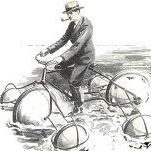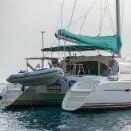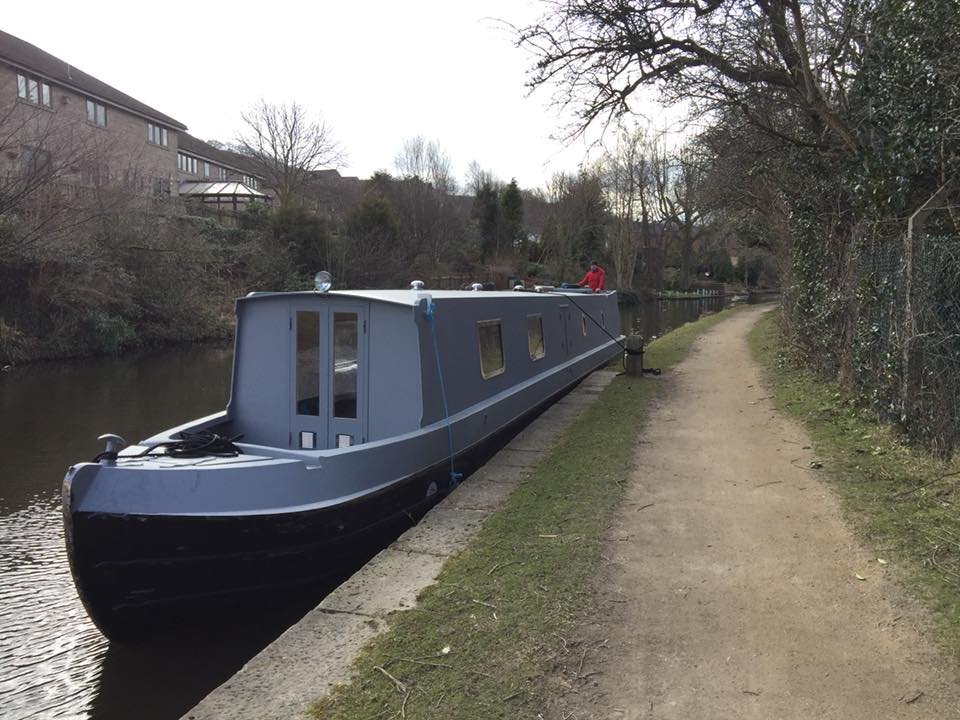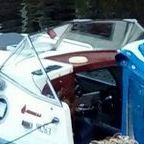Leaderboard
Popular Content
Showing content with the highest reputation on 20/03/19 in Posts
-
This post cannot be displayed because it is in a forum which requires at least 10 posts to view.
-
This post cannot be displayed because it is in a forum which requires at least 10 posts to view.
-
This post cannot be displayed because it is in a forum which requires at least 10 posts to view.
-
This post cannot be displayed because it is in a forum which requires at least 10 posts to view.
-
This post cannot be displayed because it is in a forum which requires at least 10 posts to view.
-
This post cannot be displayed because it is in a forum which requires at least 10 posts to view.
-
It's being identifiable and having to buy a licence that upsets most of the stealth boats ...3 points
-
This post cannot be displayed because it is in a forum which requires at least 10 posts to view.
-
It is indeed Bob May’s boat and you are correct, his health has declined and is the reason for the sale, sadly. A cracking boat, I did some work in the back cabin a couple of years ago. More than worth a look for anyone who appreciates quality craft. Bob was a professional photographer, one of his on display in the saloon featured a cat asleep on the rear fenders....cat on the tip cats, you might say.3 points
-
This post cannot be displayed because it is in a forum which requires at least 10 posts to view.
-
How deep is the rust and is there significant pitting? Rust converters are a last resort compromise, the ideal is to get right back to bare metal and just use a good primer, I particularly like Bondaprimer. If you wanted to be really flash you could even use a surface tolerant epoxy primer but they tend to come in big tins. Use an angle grinder, probably with a course sanding disc, to get back to bare metal, taking care to not mess up any steel that will be visible. A few small pits can be "dug out" with a grinding stone in a Dremmel. If you get to bare metal then don't use a rust converter "just in case" because thats daft. If you have just a tiny bit of rust at the bottom of pits you can ignore it, it will be fine, but dab on a bit of converter if you wish. If you can not get to bare metal then use a rust converter, but you are likely slowing down the rust rather than stopping it. ..............Dave2 points
-
This post cannot be displayed because it is in a forum which requires at least 10 posts to view.
-
I was off work today as i had to go to the hospital so as it was a nice day fro once i grabbed the chance to start the canopy patterns. What pain in the arse that was, just the two rear hardtop corners to get a nice curve to the canvas.The Material i got for the patterns is spot on ( Fibretex ) flexible and no stretch at all. This is the corners that proved difficult o get it how i wanted. All sorted now though. image: https://i.postimg.cc/yN38h78H/20190320-114414.jpg image: https://i.postimg.cc/HndWC54Y/20190320-114418.jpg image: https://i.postimg.cc/qv57CN0w/20190320-114411.jpg So then it was mark it all up time for the top section. image: https://i.postimg.cc/bJXN34Z2/20190320-134512.jpg Then i made a full rear section although this will done in smaller sections. So the top trim to go all around the top section dropping down by 6 inch. Rear section will have a rear window which can be rolled up or removed all together leaving corner upstands about 6 inch down the sides and rear. to leave all open i we want. image: https://i.postimg.cc/cHN0QYzR/20190320-155948.jpg image: https://i.postimg.cc/LsPmYvx4/20190320-152628.jpg I have gone with Lift the Dot fittings all around and the rest will be Zips fro material to material for detachable sides and rear. I lowered a bit more the hoop to hope to get a better run off. If not i have aspring loaded bar that can slot in the canopy top when not on board to give a more support. Looking again at these pics it doesnt look to taught but its better than the pics, i cant remember if i took these be for i give it fettle more. Saying that if it works i will be amazed lol Captain Faffer2 points
-
Do you think that the responde from CRT to ignoring their rules may be to say that those who do so are depriving CRT of income which is used to stock the waterways to allow anglers to enjoy their pastime? Crt get little enough from fishermen as it is without some anglers evading payment. Howard2 points
-
2 points
-
Many years ago I almost had ISO9000 forced upon me, and did wonder if I could achieve it by guaranteeing to be consistently inconsistent. ? ...............Dave2 points
-
An update from here on progress after being out a few days and why setting up a system is not that straightforward. Once commissioned then yes, simple. These batteries are outstanding. Sucking up every bit of power thrown at them. None of this watching tail current decaying slowly from 80% full. In normal use, these batteries are going to be simpler to look after than LA's. We use 100Ahrs overnight (typical) and the last few days the solar has put an additional 50Ahrs back in per day. With 300 useable Ahrs in the 480Ahr bank (maybe more), that means you can go 5 days without running the engine. In the summer with a bit more sun then we will never need to run the engine. No need to fully charge. Once you get into a cruising routine, then maybe once every 6-8 weeks think about taking them up to 100% to synchronise the amp hour counter......and not think about them otherwise. This fits in well with Peter's....it is simple. It really is..... BUT. Initially, there is the 'not so simple' construction of a system to prevent overcharging and over -voltage. The 3 peeps on here have all got slightly different DIY systems and mine is different again. Anyone thinking about going the LiFePo4 route needs to pay attention to the differences. The snag I am coming up against is that I had hoped to terminate charging from the various charging devices by voltage alone. Peter does his by voltage but he is ONLY using Solar so easy to control that source. T&B charge normally via the alternator and that backs off when it reaches a voltage and tail current (via an Arduino device) and MP has an Arduino device that disconnects all his charge devices based on voltage AND tail current. In practice, the voltage target to get to 85% SoC increases with increasing charge current, so I would need to terminate charge at say 14.0V if charging with our alternator on a 45A setting, at say 13.8V for charging via an IP22 at 30A and maybe 13.6-13.7V if the solar is only putting out 10-20A. MP has been trying to tell me this for weeks. Its only now the message has been understood having played with it for 2 weeks. I have found that tail current drops rapidly over 30 mins or so once SoC gets over 95%. Up to 95% the charge current is rock solid. No reduction at all. If you have a controller that can measure and use the current measurement, then termination is easy. Problem is that you need some sort of 'brain' (ie an Arduino) to monitor voltage and current. Unfortunately the BMV 712 measures tail current but current is not one of the options you can set off alarms or the relay. The Arduino seems a very good solution. I will try and see if I can find a compromise based on voltage with maybe choosing 13.8V as the terminating voltage and accepting that if charging over 50A I will only get to 70% SoC (but that is fine anyway). The only issue I see then is if I have a day of 4-5hours motoring and getting up 90% (so it doesnt terminate) and then getting lots of solar late in the afternoon. I am not sure if the backstop of the cell monitoring BMS box that disconnects at 3.8V would ever be triggered. With the Sterling AtoB attached to the alternator I have 4 battery type settings that vary not only the absorption voltage but the current. The two gel settings give me 45A and 55A so I have a number of various permutations. I need a few days of good sunshine to test the high voltage disconnect. One other problem I found was my two solar controllers fighting with each other. Sorted that by just using the 30A mppt for all the panels (total 500W). Peter's 'solar only' is a very simple system with no dramas at all. Once I understand the top end disconnection, mine will be very simple as well.2 points
-
This post cannot be displayed because it is in a forum which requires at least 10 posts to view.
-
This post cannot be displayed because it is in a forum which requires at least 10 posts to view.
-
2 points
-
That is the origin of the "London Whiteout" look - paint everything with white paint so it looks like a flat on a property development programme. I detest the look, but do understand why people go for it. I use magnolia ...2 points
-
Hi there, New to this forum, it looks very good. My friend has bought a Dutch cruiser steel boat which is needing a lot of repair around the windows as they leak due to the metal being so rusted. The plan is to treat the rust and take out the windows to reseal them. However it will probably be the case that when the windows are removed the rusted decaying metal surrounding the windows will break away so welding new metal is going to be required. I have been looking at what marine metal to purchase for this job - any suggestions please? The boat is on canal not on the ocean but was originally designed for the sea. Any advise will be greatly appreciated many thanks in advance Sparkz1 point
-
Hi all Thank you very much for your replies and suggestions - they're very helpful! I'll try to post a couple of photos tomorrow. I really hope that rust isn't too bad under the window edges and I won't be left with holes?? Thanks again!1 point
-
I have to say that on the occasions that I have a car with satnav I always turn off the voice. On the dashboard I invariably have a speedometer, fuel gauge, a variety of warning lights and tend to regard the satnav as just something else that I can visually check at a time of my choosing when there isn't anything going on ahead of me that requires additional attention. Likewise, I will converse with passengers if there isn't anything going on ahead that requires additional attention but then I will immediately drop out of any conversations should something occur. The problem with leaving the voice on is that it may be trying to pass information when my concentration is required elsewhere so I either don't hear it, or only hear part of it whereas by just glancing at the satnav screen when necessary I get the information required without being distracted any more than I am when I look at the speedometer or check for warning lights.1 point
-
Until we can't buy red diesel anymore and then you'll be paying £1.50 per litre for diesel ...1 point
-
This post cannot be displayed because it is in a forum which requires at least 10 posts to view.
-
The big advantage of Vactan is that you don’t have to wash it off. Thereby avoiding adding the one thing that you don’t want on unprotected metal - water. It also functions as a primer. So so what I do on rusty steel is clean up all the loose stuff, brush Vactan all over the area and wait for it to thoroughly dry. Then undercoat, then topcoat.1 point
-
Yes I do have a diesel stove, (it came with the boat and i was sceptical of it at first, especially until I got it working properly). Before that I had 22 years of shared ownership boats with solid fuel stoves on. Both work well and heat the boat up, but only one doesnt coat the inside of the boat with ash dust, only needs cleaning once a month and is controllable ?1 point
-
I think the time and research involved in the design stage is worth it in the end. I certainly spent a long time reading up and researching the different options before deciding the route I went down. Pleased I did as now they're installed they just sit there and work! Occasionally glance at the BMV to see if I need to charge or not. Definitely less monitoring and much easier to look after than lead acid. Getting very good results from solar at the moment, much better than expected based on last years performance. Might need to keep eye on charging and voltages as solar input increases to check I've got the optimum settings for the solar controller. Once set up they really are fit and forget though. As I mentioned previously, we charge to 100% to synchronise the BMV every 4-6 weeks or so, generally to coincide with a cruise to pump out. We find generally the BMV remains fairly accurate now we've tweaked the settings though. It's interesting to see the data from other installs, particularly how much the charge rate affects SOC as various voltage points are reached during charging. One of our alternators has developed a fault and consequently the batteries are now at much higher SOC by the time 14.0v is reached, although it is obviously taking a lot longer. Max charge at present is 65-70a compared to 100a with both alternators working well. We tend to leave everything switched on when leaving the boat now, it doesn't matter if they sit for a week or more at partial SOC. I figure the low voltage cut out on the fridge will stop the batteries getting excessively drained, and solar (even in winter) will keep up with minor power usage (WiFi router etc). I notice peterboat and me just enjoy using the batteries now they've been installed for a while, enjoying their benefits and superiority over lead acid, and basically ignore them! Hopefully MP and Dr Bob will have the same benefits when their installs settle in and any teething problems are sorted out. It's been interesting reading the different routes that have people have taken to hopefully get the same end result. I think the 4 installs on this thread have taken 4 quite different routes, so will be interesting to follow how these different methods compare and hold up over time.1 point
-
This post cannot be displayed because it is in a forum which requires at least 10 posts to view.
-
Mr Smelly - I don't! That's why I keep knackering my batteries! (That and advice like "just give em a good charge once a week or so"). I use the s/g, which actually may be fairly well calibrated, because when it gets to 100%, the solar would typically be putting in <1amp. (remember my 440ah battery bank is down to about 100a total capacity!). I have a shunt to connect, but the battery access is poor so I was putting it off until I either replace them or go lithium and do a full re wire etc. I think cuthound may be right - 93% efficiency at full load but if I am using it for small current draw that figure looks very different.1 point
-
1 point
-
1 point
-
1 point
-
That's great, but I'm using mine differently, and getting accurate answers to questions like "how many days/hours 'till the batteries are flat" and "can I go away for a week and leave the fridge on" would be useful. MP.1 point
-
I know you new to lifePo4s are enjoying yourselves but why? I have solar, every day it charges, at the end of the day my state of charge says 13.3 volts next morning they charge again until they are full or the sun stops shining? It really is that simples! These batteries work and work well, far better than LAs and the only things that will kill them is over or under voltage's so stop worrying and stop scaring the general boater1 point
-
1 point
-
Thoughts from 'life' and not necessarily directly related to boats - "No foot, No Horse" I still have several pairs of shoes bought from Trickers of St. James St. London - some thirty years ago... My point is that the hull is the foundation of a boat. If that is deficient in design and execution it can and WILL cause problems later and there's a strong possibility that repairing poor welds and bad layout, execution of hidden structural members may be impractical to fix. A boat's hull in not merely a tin box into which folks add their extras. I bought my shoes and my hull from craftsmen - not from a production line.1 point
-
1 point
-
I think you have hit the fundamental limitation of an open loop Hall effect sensor. In fact 5% is quite good, considering! Hall effect sensors usually have quite a temperature coefficient both in terms of offset and gain, so I wonder if measuring the temperature of the sensor and applying some compensation in software might help improve it (unless of course it already has such compensation built it). You also have the issue of the differing charge efficiency factors of the LA and the Li batteries, the former of which will vary according to state and rate of charge. Anyway, if the 5% is fairly repeatable it would be easy to build compensation into the code. That would likely improve things. But ultimately I think you should consider using a more conventional resistive shunt.1 point
-
1 point
-
This post cannot be displayed because it is in a forum which requires at least 10 posts to view.
-
This post cannot be displayed because it is in a forum which requires at least 10 posts to view.
-
i just dont why folk are so awkward when it come to this, God sake display the details, no reason not to at all.1 point
-
1 point
-
Can't find it. Rather than getting involved in the bother and hassle with it,can you just move it along a few yards and tie it up with mooring pins?1 point
-
This post cannot be displayed because it is in a forum which requires at least 10 posts to view.
-
I'm sure, but you tend to use that finny staggered cross through thing so you probbly didn't look for it before. So they've modified a gas canister into a gas locker ? how meta....1 point
-
Just the usual NBTA nonsense. I think they should be sued for misrepresentation because "Travelling" is the last thing they are interested in.1 point
-
It would be really interesting to see what modelling you could do with a neural net on the data from a Lithium bank. The modelling of SoC from voltage on a Lead acid bank (Gibbo's) used only one voltage reading (and its rate of change and then its derivative) but for Lithiums you also have each individual cell voltage...giving 5 voltages to consider. As MP says, each cell performs differently. I havent got a cell voltage logger on mine as MP has so can only auto log the overall bank voltage, but from the limited manual cell logging I am doing, I can see all sorts of trends at the cell level. The rate of change of cell voltage varies significantly from cell to cell under high load or high charge compared to low load - viz one cell will go down faster than another on deep discharge but on high charge they will be very similar. There is therefore 4 times (maybe 5 times) more data to consider in building a model and multiple effects going on all the time. The 'old' PLS or MLR techniques wouldn't be capable of following what is going on but the new techniques of neural nets, topology, sparse data etc are ideal. The question then though is what could you do with advanced modelling? From my limited experience it seems easy to see when you are at 100% SoC, ie the tail current drops to 2-5% at a rising charge voltage - and this rise happens quickly - (as Tom and MP have advised). The charge voltage at this point appears from what Tom has said will vary dependent on Charge rate, so at a charge of 30A, both MP and I have seen a voltage of 14.00V giving 100% and a voltage of 13.80V giving circa 95%. A futher set of Tom's data shows (IIRC) a voltage of nearly 13.9V giving 95% at 40A charge. Tom is reporting 14.0V needed to get over 80% at higher charge rates (80A? - Tom's bank is also 33% smaller than MP and mine hence that 80A is more like 100A for us). It would be useful to collect data to see if you can plot charge rate versus voltage to give 95% charge. I will try and do it myself via my different charge sources. For each charge source you should be able to identify the voltage limit for 95% charge....and then just avoid that unless you want to re-set your BMV or amp hour counter. Gibbo put a lot of effort into getting a model to determine SoC but in his case, he needed to be accurate as it was important to get to 100%. 90% wasnt good enough. Lithium's are far less demanding. Dont let the voltage get over a certain point for each charge source. ( I guess the next question is how much does temperature vary this decision point). I assume the same is true at the low voltage end....but not a clue as I have not been there yet. There will be an issue with the amp hour counter varying and I am sure that is where the neural net would work, but just taking the bank up to 100% (or 95%) every 6-8 weeks resolves this ...and you will then understand how much drift you get in that 6-8 week period....but one of the references used earlier in this thread did push the point that you need to go to 95-100% now and again to keep the batteries at their best, claiming a memory effect. So bottom line is that you will go to 100% now and again and that will re-set the BMV/amp hour counter. It really does seem easy to look after these batteries with little or no input, providing you scope out first your charge source characteristics and learn the limitations of your system. If anyone has data on voltages at 95% or 100% SoC with different charge rates, then let me have it and I will see if they are comparable.1 point
This leaderboard is set to London/GMT+01:00



























